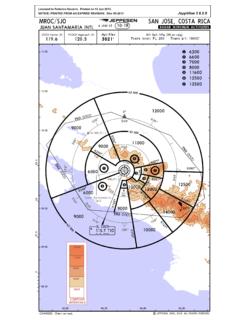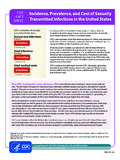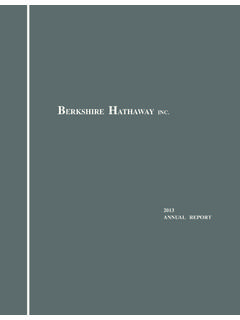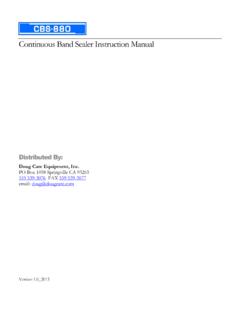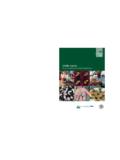Transcription of ISSN 0081-4539 2013 - Home | Food and …
1 ISSN 0081-4539 . 2013 . 2013 . THE STATE. OF food . AND. agriculture . THE STATE. 2013 . Malnutrition in all its forms undernutrition, micronutrient deficiencies, and overweight and obesity imposes unacceptably high economic and social costs on countries at all income levels. Improving nutrition and reducing these OF food . AND. costs requires a multisectoral approach that begins with food and agriculture and includes complementary interventions in public health and education. The agriculture . traditional role of agriculture in producing food and generating income is fundamental, but the entire food THE STATE OF food AND agriculture .
2 System from inputs and production, through processing, storage, transport and retailing, to consumption can contribute much more to the eradication of malnutrition. Agricultural policies and research must continue to support productivity growth for staple foods while paying greater attention to nutrient-dense foods and more sustainable production systems. Traditional and modern supply chains can enhance the availability of a variety of nutritious foods and reduce nutrient waste and losses. Governments, international organizations, the private sector and civil society can help consumers choose healthier diets, reduce waste and contribute to more sustainable use of resources by providing clear, accurate information and ensuring access to diverse and nutritious foods.
3 food SYSTEMS. FOR BETTER NUTRITION. ISBN 978-92-5-107671-2 ISSN 0081-4539 . FAO. 9 7 8 9 2 5 1 0 7 6 7 1 2. I3300E/1 Photos on front cover and page 3: FAO Mediabase. FAO information products are available on the FAO website ( ). and can be purchased through ISSN 0081-4539 . 2013 . THE STATE. OF food . AND. agriculture . food AND agriculture ORGANIZATION OF THE UNITED NATIONS. Rome, 2013 . I3300E Disclaimer 1 07/05/ 2013 20:44. C. M. Y. CM. MY. CY. CMY. K. The designations employed and the presentation of material in this information product do not imply the expression of any opinion whatsoever on the part of the food and agriculture Organization of the United Nations (FAO) concerning the legal or development status of any country, territory, city or area or of its authorities, or concerning the delimitation of its frontiers or boundaries.
4 The mention of specific companies or products of manufacturers, whether or not these have been patented, does not imply that these have been endorsed or recommended by FAO in preference to others of a similar nature that are not mentioned. ISBN 978-92-5-107671-2 (print). E-ISBN 978-92-5-107672-9 (PDF). FAO 2013 . FAO encourages the use, reproduction and dissemination of material in this information product. Except where otherwise indicated, material may be copied, downloaded and printed for private study, research and teaching purposes, or for use in non-commercial products or services, provided that appropriate acknowledgement of FAO as the source and copyright holder is given and that FAO's endorsement of users' views, products or services is not implied in any way.
5 All requests for translation and adaptation rights, and for resale and other commercial use rights should be made via request or addressed to FAO information products are available on the FAO website ( publications) and can be purchased through iii Contents Foreword v Acknowledgements vi Abbreviations and acronyms viii Executive summary ix food systems for better nutrition 1. 1. The role of food systems in nutrition 3. Why is nutrition important? 4. Why focus on food systems to address malnutrition?
6 6. food systems and nutrition opportunities 7. Cross-cutting issues in nutrition-sensitive food systems 9. Knowledge and information gaps 11. Structure of the report 12. 2. Malnutrition and changing food systems 13. Malnutrition concepts, trends and costs 13. food system transformation and malnutrition 20. Conclusions and key messages 24. 3. Agricultural production for better nutrition 26. Making food more available and accessible 26. Making food more diverse 30. Making food more nutritious 33. Conclusions and key messages 36.
7 4. food supply chains for better nutrition 37. Transformation of food supply chains 37. Enhancing nutrition through food supply chains 42. Conclusions and key messages 47. 5. Helping consumers achieve better nutrition 49. food assistance programmes for better nutrition 49. Nutrition-specific food price subsidies and taxes 52. Nutrition education 54. Conclusions and key messages 59. 6. Institutional and policy environment for nutrition 61. Building a common vision 61. Better data for better policy-making 65.
8 Effective coordination is essential 65. Key messages of the report 67. Statistical annex 69. Notes for the annex table 71. Annex table 73. References 83. Special chapters of The State of food and agriculture 98. iv TABLES. 1. Disability-adjusted life years in 1990 and 2010, by malnutrition-related risk factor, population group and region 18. 2. Biofortified staple food crops implemented by the HarvestPlus programme and actual or expected release year 35. BOXES. 1. Sustainable production and consumption 4.
9 2. The importance of animal-source foods in diets 11. 3. The urban rural malnutrition divide 14. 4. Limitations of using the body mass index in measuring excessive body fat 17. 5. The first thousand days 29. 6. Increasing dietary diversity through home gardens 31. 7. Improving child nutrition in small-scale pastoral food systems 32. 8. Improving livelihoods and nutrition throughout the bean value chain 43. 9. food processing, preservation and preparation in the home and micronutrient intakes 45. 10.
10 The Grameen Danone Partnership 46. 11. Guiding principles for improving nutrition through agriculture 62. 12. Nutrition governance at the international level 63. FIGURES. 1. food system interventions for better nutrition 8. 2. Prevalence of stunting, anaemia and micronutrient deficiencies among children, by developing region 16. 3. Prevalence of overweight and obesity among adults, by region 17. 4. The multiple burdens of malnutrition 21. 5. The food system transformation 22. 6. Share of countries in each malnutrition category, by level of agricultural productivity 22.











